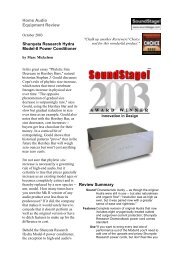Download Model 5 brochure
Download Model 5 brochure
Download Model 5 brochure
You also want an ePaper? Increase the reach of your titles
YUMPU automatically turns print PDFs into web optimized ePapers that Google loves.
stage we managed to eliminate, we reduced the<br />
distortions of the transistors and increased the linear<br />
bandwidth of the circuitry,” explains Matthias<br />
Ruff. The MODEL5 achieves bandwidth of more<br />
than 220 kHz. This is practically four octaves above<br />
the frequency response of a CD. Even the high<br />
resolutions of modern recording technologies like<br />
SACD and Super AUDIO DVD are handled with<br />
ease. The MODEL5 is so fast that even highest frequencies<br />
above the audio spectrum are amplified<br />
linearly. “The faster the forward signal is processed,<br />
the higher the frequencies of the feedback distortions<br />
occur. With the MODEL5 these problems are practically<br />
immeasurable and far beyond the audio<br />
range,” describes Matthias Ruff.<br />
LOCAL LINEARISATION<br />
Another disadvantage of an OVERALL LOOP<br />
FEEDBACK is that it is not the cause of a problem<br />
but only the result of a problem when corrected. A<br />
distortion generated in the second stage of the amplifier<br />
is not being eliminated at the point of origin,<br />
but only at the end as the sum of all stages. Not the<br />
actual reason but only the symptoms are being fixed.<br />
Matthias Ruff gives us a simple example which<br />
explains this correlation more easily: “Just imagine<br />
you put on some shoes which are too small. After a<br />
while you get blisters on your feet. A lotion and<br />
band-aid will now alleviate the symptoms but not<br />
the cause! If you have a better and faster feedback<br />
from your feet, you would have immediately put on<br />
some bigger shoes. The problem would have been<br />
solved and the blisters would not have developed.”<br />
MINIMAL Single Stage FEEDBACK<br />
Nevertheless Avantgarde Acoustic did not want to<br />
completely abandon the effective OVERALL LOOP<br />
FEEDBACK. Matthias Ruff has a clear point of view<br />
in this matter: “People normally only see black or<br />
white. Mostly the feedback applied is completely<br />
‘over the top’ or left out totally as in ZERO FEED-<br />
BACK designs. Both solutions have many disadvantages.<br />
For me the happy medium is the best solution”.<br />
The percentage of distortions generated by the<br />
MODEL5 itself are inherently small in comparison<br />
to normal amplifiers, as it only has two transistors<br />
in the signal path, which are even linearised independently<br />
by special circuits. For this reason the<br />
OVERALL LOOP FEEDBACK can be applied very<br />
carefully. According to the manufacturer only the<br />
large distortions of the circuitry are equalized.<br />
“I purposely do without strong feedback only to get<br />
good specifications. If you take into consideration<br />
that normal speakers produce higher distortions<br />
(by approximately 10%) than amplifiers, you can<br />
see that amplifier distortions are highly overrated”.<br />
The designer emphasizes that he has chosen maximum<br />
resolution in practical operations instead of<br />
optimising for negligible technical specifications.<br />
The main objective is to make the amplifier as fast<br />
as possible so that even the finest details of music<br />
are reproduced accurately.<br />
This example makes the biggest disadvantage of a<br />
high OVERALL LOOP FEEDBACK in multi stage<br />
amplifier designs more obvious: a mistake occurs,<br />
after some time it develops into a problem and only<br />
than is cured. “The most important thing is to detect<br />
the defect immediately at its point of origin. If you<br />
than know what’s going wrong, you have to treat<br />
the cause precisely and the treatment must solve the<br />
problem quickly”. According to Matthias Ruff the<br />
key to success is a local linearisation concept. For<br />
this reason both amplification stages of the MODEL5<br />
are linearised separately. The BI-POLAR driver stage<br />
as well as the MOS-FET power transistors have<br />
their own linearisation circuitry. Each deviation is<br />
detected at the point of origin and immediately<br />
linearised, independent of the adjacent stage. “We<br />
are working with automatically self-smoothing subsystems<br />
which autonomously do their work and<br />
efficiently reduce distortions”.<br />
But how does the MODEL5 with its relatively low<br />
feedback behave on complex loads? “The more<br />
amplification stages one is using, the slower the<br />
circuit is and the more negative the EMF forces


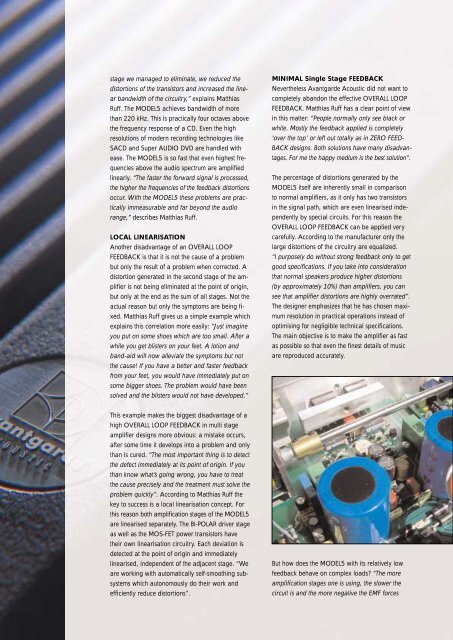
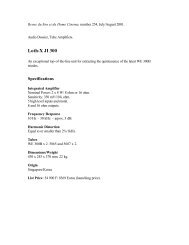


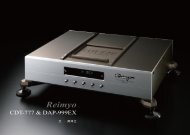

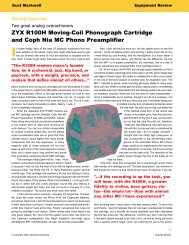
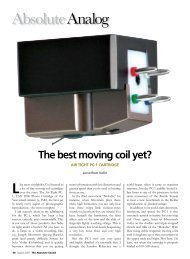
![DAP-999 EX Limited [pdf] - Audio Note Singapore](https://img.yumpu.com/27191044/1/190x253/dap-999-ex-limited-pdf-audio-note-singapore.jpg?quality=85)

![Harmonix CS-120 Improved-Version [pdf]](https://img.yumpu.com/24411255/1/184x260/harmonix-cs-120-improved-version-pdf.jpg?quality=85)
